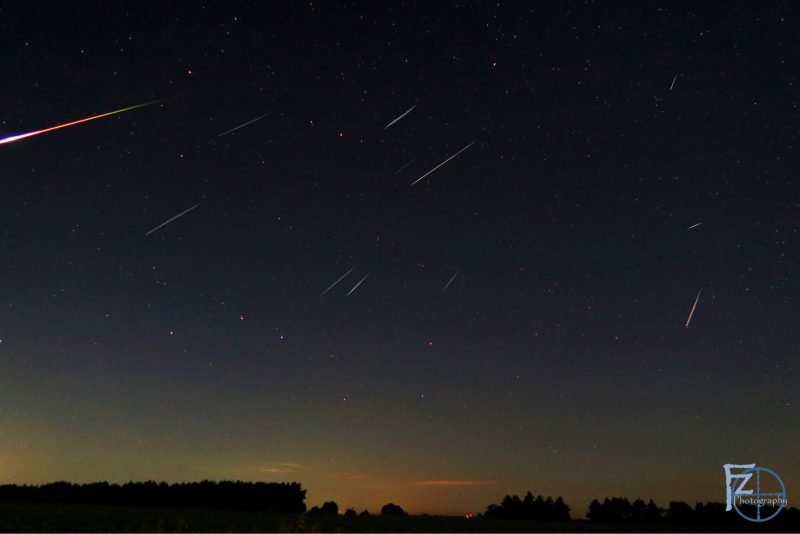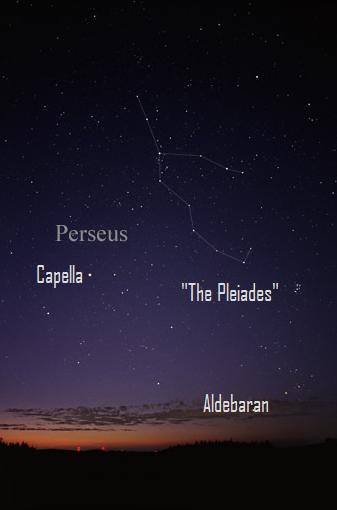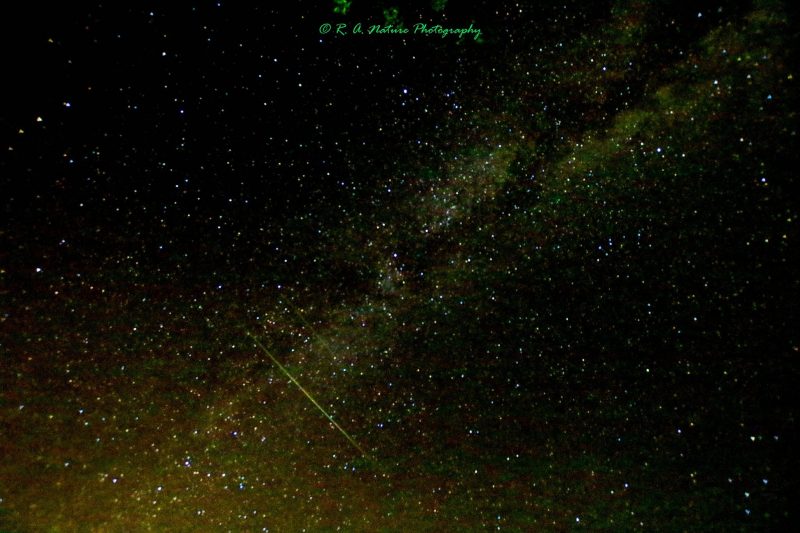Enjoy the Perseids in the Boundary Waters
A place with no light pollution is the perfect place to watch a meteor shower. The Boundary Waters, Quetico Park or the Gunflint Trail are a few options for this year’s Perseids which will be extra special because of the almost moonless nights.
Start watching for Perseids now
Peak mornings – August 11, 12 and 13 – are moon-free. With only a slim waning moon up before dawn this week, start watching in a dark sky now.
No matter where you live worldwide, the 2018 Perseid meteor shower will probably produce the greatest number of meteors on the mornings of August 11, 12 and 13. In a dark, moonless sky, this annual shower often produces some 50 meteors per hour … often many more. And this year, in 2018, there’ll be no moonlight to ruin the show.
It’ll be an awesome year to watch the Perseids!
In the Northern Hemisphere, we rank the August Perseids as an all-time favorite meteor shower of every year. For us, this major shower takes place during the lazy, hazy days of summer, when many families are on vacation. And what could be more luxurious than taking a siesta in the heat of the day and watching this summertime classic in the relative coolness of night?
When and how should I watch the Perseid meteor shower in 2018? The best time to watch most meteor showers is between midnight and dawn, and the Perseids are no exception. The best mornings are probably August 11, 12 and 13. The best skies are those far from city lights.
At this writing (August 7, 2018), the moon is a waning crescent up before dawn, in the peak Perseid hours. It might interfere some with your view of any early Perseids that happen to be flying, but it won’t interfere much, and might even enhance your enjoyment of the early morning sky. Plus a crescent moon is easy to blot out by sitting in the shadow of a tree or building. And, as the days leading up to new moon pass, the moon will be rising closer and closer to the time of sunrise. New moon will be August 11.
So don’t think you have to wait until the peak mornings to see any meteors. If you have a dark sky, start watching now!
Also remember, the the Delta Aquariid meteor shower is still rambling along steadily. You’ll see mostly Perseids but also a few Delta Aquariids in the mix.
No matter how many meteors you see, you might see something, and it might be a lot of fun.

Composite of 12 images acquired on August 13, 2017, by Felix Zai in Toronto. He wrote: “Perseid meteor shower gave a good show even though the moonlight drowned out most of the fainter ones. A huge fireball was captured in this photo.” Thanks, Felix! By the way, it’s only in a meteor “storm” that you’d see this many meteors at once. Even in a rich shower, you typically see only 1 or 2 meteors at a time. Click for more 2017 Perseids.
Don’t rule out early evenings, either. In a typical year, although the meteor numbers increase after midnight, the Perseid meteors still start to fly at mid-to-late evening from northerly latitudes. South of the equator, the Perseids start to streak the sky around midnight. If fortune smiles upon you, the evening hours might offer you an earthgrazer – a looooong, slow, colorful meteor traveling horizontally across the evening sky. Earthgrazer meteors are rare but memorable. Perseid earthgrazers appear before midnight, when the radiant point of the shower is close to the horizon.

From mid-northern latitudes, the constellation Perseus, the stars Capella and Aldebaran, and the Pleiades cluster light up the northeast sky in the wee hours after midnight on August nights. The meteors radiate from Perseus.

Here’s a cool binocular object to look for while you’re watching the meteors. The constellation Cassiopeia points out the famous Double Cluster in northern tip of the constellation Perseus. Plus, the Double Cluster nearly marks the radiant of the Perseid meteor shower. Photo by Flickr user madmiked.
General rules for Perseid-watching. No special equipment, or knowledge of the constellations, needed.
Find a dark, open sky to enjoy the show. An open sky is essential because these meteors fly across the sky in many different directions and in front of numerous constellations.
Give yourself at least an hour of observing time, for the meteors in meteor showers come in spurts and are interspersed with lulls. Remember, your eyes can take as long as 20 minutes to adapt to the darkness of night. So don’t rush the process.
Know that the meteors all come from a single point in the sky. If you trace the paths of the Perseid meteors backwards, you’d find they all come from a point in front of the constellation Perseus. Don’t worry about which stars are Perseus. Just enjoying knowing and observing that they all come from one place on the sky’s dome.
Enjoy the comfort of a reclining lawn chair. Bring along some other things you might enjoy also, like a thermos filled with a hot drink.
Remember … all good things come to those who wait. Meteors are part of nature. There’s no way to predict exactly how many you’ll see on any given night. Find a good spot, watch, wait.
You’ll see some.

Earth encounters debris from comet, via Astro Bob.
What’s the source of the Perseid meteor shower? Every year, from around July 17 to August 24, our planet Earth crosses the orbital path of Comet Swift-Tuttle, the parent of the Perseid meteor shower. Debris from this comet litters the comet’s orbit, but we don’t really get into the thick of the comet rubble until after the first week of August. The bits and pieces from Comet Swift-Tuttle slam into the Earth’s upper atmosphere at some 130,000 miles (210,000 km) per hour, lighting up the nighttime with fast-moving Perseid meteors.
If our planet happens to pass through an unusually dense clump of meteoroids – comet rubble – we’ll see an elevated number of meteors. We can always hope!
Comet Swift-Tuttle has a very eccentric – oblong – orbit that takes this comet outside the orbit of Pluto when farthest from the sun, and inside the Earth’s orbit when closest to the sun. It orbits the sun in a period of about 133 years. Every time this comet passes through the inner solar system, the sun warms and softens up the ices in the comet, causing it to release fresh comet material into its orbital stream.
Comet Swift-Tuttle last reached perihelion – closest point to the sun – in December 1992 and will do so next in July 2126.

The radiant point for the Perseid meteor shower is in the constellation Perseus. But you don’t have to find a shower’s radiant point to see meteors. Instead, the meteors will be flying in all parts of the sky.
What is the radiant point for the Perseid meteor shower? If you trace all the Perseid meteors backward, they all seem to come from the constellation Perseus, near the famous Double Cluster. Hence, the meteor shower is named in the honor of the constellation Perseus the Hero.
However, this is a chance alignment of the meteor shower radiant with the constellation Perseus. The stars in Perseus are light-years distant while these meteors burn up about 100 kilometers (60 miles) above the Earth’s surface. If any meteor survives its fiery plunge to hit the ground intact, the remaining portion is called a meteorite. Few – if any – meteors in meteor showers become meteorites, however, because of the flimsy nature of comet debris. Most meteorites are the remains of asteroids.
In ancient Greek star lore, Perseus is the son of the god Zeus and the mortal Danae. It is said that the Perseid shower commemorates the time when Zeus visited Danae, the mother of Perseus, in a shower of gold.

Russ Adams caught these 2 meteors, traveling on parallel paths, on the morning of August 11, 2017. Click for more 2017 Perseids.
Bottom line: The 2018 Perseid meteor shower is expected to produce the most meteors in the predawn hours of August 11, 12, and 13. But with only a slim crescent moon up before dawn now, you can start looking for Perseid meteors now!

Leave a Reply
You must be logged in to post a comment.